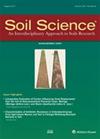不同施肥技术对“纯”或混合施肥地下带氮动态的影响
4区 农林科学
Q2 Agricultural and Biological Sciences
引用次数: 1
摘要
摘要增效肥料(EEF)技术利用产品涂层延迟氮(N)释放或化学稳定化以抑制土壤中氮转化的关键步骤,具有提高农业系统氮利用效率(NUE)的潜力。然而,单一技术的氮素释放和转化的动态可能导致生长季节氮素供需的空间或时间不匹配。这可以通过使用不同技术的共混物来克服,前提是稳定产物浓度的降低不会降低有效性。实验室培养量化了控释肥料(CRF)和硝化抑制(NI)尿素以及这些技术的不同混合物周围的N动态,并将其与传统尿素和可生物降解的植物油包覆尿素(POCU)进行比较,这些尿素在两种对比土壤中以相同的速率施用60天。NI尿素(3,4-二甲基吡唑磷酸脲,DMPP尿素)和CRF(聚合物包覆尿素,PCU)的混合物通常会导致N的浓度和分布介于未混合应用的组成产品之间。每种产物的比例变化反映了两种土壤中尿素氮(尿素- n)浓度的变化,而每种混合物中DMPP尿素的比例仅与Vertisol中硝化抑制的程度有关。部分POCU颗粒在孵化的早期阶段破裂,导致最初的矿物氮浓度高于PCU。与颗粒尿素相比,两种CRFs均延迟了氮素的释放和硝态氮(NO3-N)的形成,且矿质氮在两种土壤中的分布相似。土壤类型对带状氮素动态有显著影响。氮肥处理对Ferralsol中NO3-N产量的影响不大,而verversol中溶质运输的阻抗较高,导致NI尿素在纯DMPP和混合DMPP尿素处理中对硝化作用的抑制作用显著。以NO3-N产量作为环境损失风险的基准,该土壤的肥料处理效果为DMPP尿素/ PCU混合施用(PCU比例较高可能产生较小但不显著的效益)> DMPP尿素= PCU >尿素。这些发现强调了土壤性质在确定不同带状EEF产品的N动力学中的重要性。生物可降解聚合物涂层替代品的有效性和混合EEF产品的有效性可以提高N供应的可靠性,同时减少对环境的影响,因此为可持续提高种植系统中的肥料氮肥利用效率提供了更大的机会。本文章由计算机程序翻译,如有差异,请以英文原文为准。
Impact of contrasting fertilizer technologies on N dynamics from subsurface bands of “pure” or blended fertilizer applications
Abstract. Enhanced efficiency fertilizer (EEF) technologies that
employ product coatings to delay nitrogen (N) release or are chemically
stabilized to inhibit key steps of N transformations in soil offer
potential for improving N use efficiency (NUE) in agricultural systems.
However, the dynamics of N release and transformation from single
technologies may result in a spatial or temporal mismatch of N supply and
demand during a growing season. This may be overcome by use of blends of
different technologies, provided the reduction in the concentration of
stabilizing products does not reduce effectiveness. Laboratory incubations
quantified the N dynamics around bands of controlled-release fertilizer
(CRF) and nitrification-inhibited (NI) urea and varying blends of these
technologies and referenced this against conventional urea and
biodegradable, plant-oil-coated urea (POCU) applied at the same rates in two
contrasting soils over 60 d. Blends of NI urea (3,4-dimethylpyrazole
phosphate, DMPP urea) and a CRF (polymer-coated urea, PCU) typically
resulted in N concentrations and distribution that were intermediate to those
of the constituent products in unblended applications. Changes in the
proportions of each product were mirrored by urea nitrogen (urea-N) concentrations around
the bands in both soils, while the proportions of DMPP urea in each blend
were only related to the extent of nitrification inhibition in the Vertisol.
A proportion of the POCU granules burst during the early stages of
incubation, resulting in initially higher mineral N concentrations compared to PCU.
However, both CRFs delayed N release and formation of nitrate nitrogen (NO3-N) relative to
granular urea, and mineral N distribution was similar within each soil. Soil
type had a significant impact on banded N dynamics. Where there was little
effect of N-fertilizer treatment on NO3-N production in the Ferralsol,
the higher impedance to solute transport in the Vertisol contributed to a
significant inhibitory effect of NI urea on nitrification in both pure and
blended DMPP urea treatments. Using NO3-N production as a benchmark for
the risk of environmental loss, the efficacy of fertilizer treatments in
this soil was of DMPP urea / PCU blends (higher ratio of PCU may offer small
but insignificant benefit) > DMPP urea = PCU > urea.
These findings highlight the importance of soil properties in determining
the N dynamics from different banded EEF products. Insights into the
efficacy of biodegradable alternatives to polymer coatings and the efficacy
of blended EEF products can improve the reliability of N supply while
reducing environmental impacts, therefore offering greater opportunities to
sustainably improve fertilizer NUE in cropping systems.
求助全文
通过发布文献求助,成功后即可免费获取论文全文。
去求助
来源期刊

Soil Science
农林科学-土壤科学
CiteScore
2.70
自引率
0.00%
发文量
0
审稿时长
4.4 months
期刊介绍:
Cessation.Soil Science satisfies the professional needs of all scientists and laboratory personnel involved in soil and plant research by publishing primary research reports and critical reviews of basic and applied soil science, especially as it relates to soil and plant studies and general environmental soil science.
Each month, Soil Science presents authoritative research articles from an impressive array of discipline: soil chemistry and biochemistry, physics, fertility and nutrition, soil genesis and morphology, soil microbiology and mineralogy. Of immediate relevance to soil scientists-both industrial and academic-this unique publication also has long-range value for agronomists and environmental scientists.
 求助内容:
求助内容: 应助结果提醒方式:
应助结果提醒方式:


